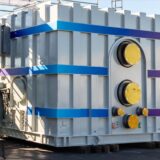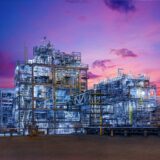ExxonMobil announces an aggressive growth strategy at today’s oil prices
“We’ve got the best portfolio of high-quality, high-return investment opportunities that we’ve seen in two decades,” Darren W. Woods, chairman and chief executive officer, said during the company’s annual meeting of investment analysts at the New York Stock Exchange last week.
“Our plan takes full advantage of the company’s unique strengths and financial capabilities, using innovation, technology and integration to drive long-term shareholder value and industry-leading returns.”
Growth plans include steps to increase earnings by more than 100% – to USD 31 billion by 2025 at 2017 prices – from last year’s adjusted profit of USD 15 billion, which excluded the impact of U.S. tax reform and impairments.
Woods said this plan projects double-digit rates of return in all three segments of ExxonMobil’s business – upstream, downstream and chemical – which are all three world-class businesses in their own right.
In the upstream, the company expects to significantly increase earnings through a number of growth initiatives involving low-cost-of-supply investments in U.S. tight oil, deepwater and liquefied natural gas (LNG). Growth coming online from new and existing projects is expected to increase production from 4 million oil-equivalent barrels per day to about 5 million.
The company plans to increase tight-oil production five-fold from the U.S. Permian Basin and start up 25 projects worldwide. Those startups will add volumes of more than 1 million oil-equivalent barrels per day. In LNG, the company expects to bring on new production to meet a projected increase in global demand.
Upstream growth will benefit from ExxonMobil’s industry-leading exploration success and strategic acquisitions. In 2017 alone, the company added 10 billion oil-equivalent barrels to its resource base in locations including the Permian, Guyana, Mozambique, Papua New Guinea and Brazil.
ExxonMobil’s downstream business is projected to double earnings by 2025 by upgrading its product slate through strategic investments at refineries in Baytown and Beaumont in Texas and Baton Rouge, Louisiana, Rotterdam, Antwerp, Singapore, and Fawley in the U.K.
These projects are expected to result in double-digit returns by enabling increased production of higher-value products, such as ultra-low sulfur diesel, chemicals feedstocks and basestocks for lubricants. As a result of these improvements, the company’s 2025 downstream margins are projected to increase by 20%.
Expansion is supported by projected demand growth in emerging markets, and includes entries into new markets such as Mexico and Indonesia. It is supported by integration with chemical manufacturing and upstream production.
In its chemical business, ExxonMobil expects to grow manufacturing capacity in North America and Asia Pacific by about 40%. That growth will be achieved in part by adding 13 new facilities, including two world-class steam crackers in the United States. These investments would enable the company to meet increasing demand in Asia and other growing markets.
“We are uniquely positioned to take advantage of the global demand growth for higher-value products in the downstream and chemical,” Woods said. “Our combined strengths in innovative technology, resource and market access, marketing product leadership and integration improve profitability and create significant shareholder value.”
Woods said the company’s overall growth strategy is designed with a key goal in mind – fully leveraging our competitive advantages to grow shareholder value across all three of our world-class businesses. Through higher returns from increased investments, the company has the potential to increase its return on capital employed to about 15% by 2025.
“Our existing business and plans for growth are robust to a wide range of price environments, allowing us to maintain a growing dividend and a strong balance sheet while returning excess cash to our shareholders,” said Woods.












